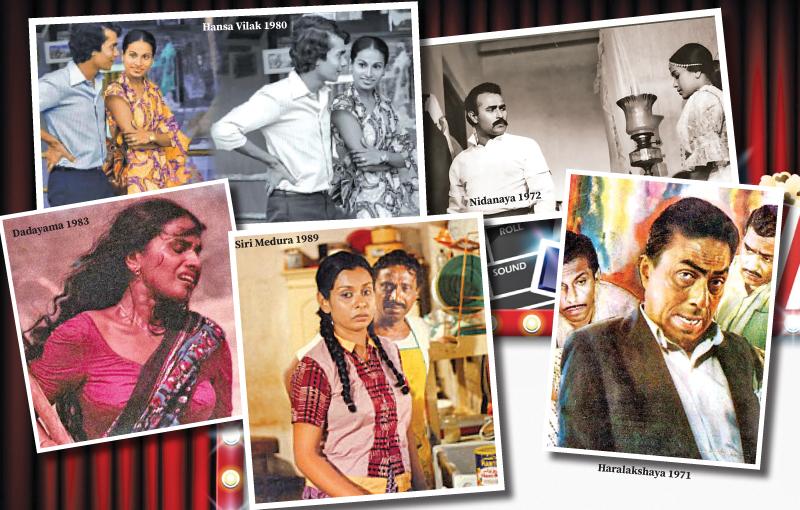
On February 17 this year, the Sri Lanka Rupavahini Corporation (SLRC) commenced the Cine Chaaya program to uplift the Sinhala film industry. The television channel aired archived copies of films that had marked important milestones in local cinema, providing the current generation with the opportunity to watch films from yesteryear.
The program was initiated on a proposal of Minister of Transport, Highways, and Mass Media, Dr Bandula Gunawardena to revive Sinhala cinema.
On Friday at 9.30 p.m. Dr. Senesh Dissanayake Bandara, a senior lecturer from the Department of Mass Communication at Sri Jayewardenepura University, offers a commentary on the film alongside an expert film critic and an industry professional. After the enlightening discussion, the film is aired at 10.00 p.m. Such commentaries are found on the blu-rays and DVDs of many Hollywood films to enhance the knowledge of film lovers.
 Bambaru Ewith 1978
|
The program seeks to educate the current generation on the history of Sri Lankan cinema and its evolution while also inspiring them to produce films of exceptional artistic quality. The efforts are evidently a resounding success as evidenced by the social media buzz the program has managed to create over the past few months.
Main obstacle
It is undeniable that a broad discussion on films and cinema is necessary to uplift the industry. Today the audience has moved away from Sinhala cinema and has instead veered towards Indian, Korean and Western cinema which has become the main obstacle to the local industry. This calls for Sri Lankan cinema to be on par with the industries of other countries.
The golden era of Sri Lankan cinema between 1960 - 70 was able to withstand these challenges with the creation of Sir Lester James Peiris’s totally indigenous film Rekhawa (Line of Destiny) in 1956. The attempts by the SLRC to educate the youth about this turning point are highly commendable.
Their focus can be observed to be centred around reviving commercial cinema to uplift the film industry as a whole. Popular and artistic movies created in the 1960s, 1970s, and 1980s were chosen and showcased to foster a greater understanding and appreciation among viewers.
The screening of these films has served as a catalyst for broader thinking and contemplation among the audience regarding cinema. This fact becomes even more apparent when we analyse the approximately 20 films that have been presented thus far.
 Higana Kolla 1979 |
Dr. Lester James Peiris’s Sandeshaya (Missive) which was released on March 30, 1960 was aired first. It was produced by K. Gunaratnam on behalf of the Cinemas Company. The screenplay was by Dr. Peiris with the assistance of Benedict Dodampegama and K.A.W Perera. The dialogues were written by Perera while Willie Blake served as the cinematographer. It was edited by Titus Thotawatta and Sumithra Peiris.
The cast included Ananda Jayaratne, Kanthi Gunatunga, Gamini Fonseka, David Dharmakeerthi, Arthur Van Langenberg, Vincent Vaas, Hugo Fernando, Eddie Jayamanne, Shane Gunaratne, Iranganie Serasinghe, Bandu Gunasekara, Douglas Wickremasinghe, Thilakasiri Fernando, Shanthi Lekha, N. R. Dias, Chris Greet, Jeevarani Kurukulasuriya, Reg Vanculenberg, Tissa Udangamuwa and Anthony C. Perera. The film was considered to be the first film to deviate from the Indian influence that overwhelmed early Sri Lankan cinema in the early days.
Sagarayak Meda
Sagarayak Meda (Amidst the Ocean) aired on the SLRC was a similarly remarkable film. It was directed by the doyen of Sri Lankan cinema, Gamini Fonseka based on a screenplay by Dharma Sri Munasinghe. The film was released on July 24, 1980 and was produced by Ananda Abeynaike. The film consisted of a talented staff and many big names in the industry at the time.
The film Sagarayak Meda gained significant attention from the audience due to suspicions surrounding the character of Minister Frederic Ramanayake, which was believed to be a portrayal of a powerful minister during that time. The controversy surrounding the film led the Minister concerned to attempt to obtain an injunction against its release, further fuelling public interest and curiosity.
Bambaru Awith (The Wasps Are Here) was yet another brilliant film by Prof. Darmasena Pathiraja aired by the SLRC under the Cine Chaaya program. The SLRC called upon its valued viewers and cinema enthusiasts to stay tuned and indulge in a remarkable cinematic experience in the weeks to come.
